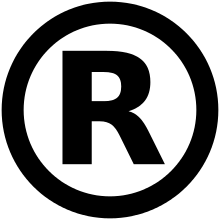Trademark infringement
| Intellectual property law and Intellectual rights |
|---|
| Primary rights |
| Sui generis rights |
| Related topics |
|
|
Trademark infringement is a violation of the exclusive rights attached to a trademark without the authorization of the trademark owner or any licensees (provided that such authorization was within the scope of the licence). Infringement may occur when one party, the "infringer", uses a trademark which is identical or confusingly similar to a trademark owned by another party, in relation to products or services which are identical or similar to the products or services which the registration covers. An owner of a trademark may commence civil legal proceedings against a party which infringes its registered trademark. In the United States, the Trademark Counterfeiting Act of 1984 criminalized the intentional trade in counterfeit goods and services.[1]:485–486
The ACTA trade agreement, signed in May 2011 by the United States, Japan, Switzerland, and the EU, requires that its parties add criminal penalties, including incarceration and fines, for copyright and trademark infringement, and obligated the parties to actively police for infringement.[2][3][4]
In many countries (but not in countries like the United States, which recognizes common law trademark rights), a trademark which is not registered cannot be "infringed" as such, and the trademark owner cannot bring infringement proceedings. Instead, the owner may be able to commence proceedings under the common law for passing off or misrepresentation, or under legislation which prohibits unfair business practices. In some jurisdictions, infringement of trade dress may also be actionable.
Where the respective marks or products or services are not identical, similarity will generally be assessed by reference to whether there is a likelihood of confusion that consumers will believe the products or services originated from the trademark owner.
Likelihood of confusion is not necessarily measured by actual consumer confusion, though normally one of the elements, but by a series of criteria Courts have established. A prime example is the test announced by the Ninth Circuit Court of Appeals in AMF, Inc v. Sleekcraft Boats, 599 F.2d 341 (C.A.9) 1979. The Court there announced eight specific elements to measure likelihood of confusion:
- Strength of the mark
- Proximity of the goods
- Similarity of the marks
- Evidence of actual confusion
- Marketing channels used
- Type of goods and the degree of care likely to be exercised by the purchaser
- Defendant's intent in selecting the mark
- Likelihood of expansion of the product lines[5]
Other Courts have fashioned their own tests for likelihood of confusion—like those announced in In re E.I. du Pont de Nemours & Co., 476 F.2d 1357, 177 USPQ 563 (CCPA 1973), known collectively as the DuPont factors.
If the respective marks and products or services are entirely dissimilar, trademark infringement may still be established if the registered mark is well known pursuant to the Paris Convention. In the United States, a cause of action for use of a mark for such dissimilar services is called trademark dilution.
In some jurisdictions a party other than the owner (e.g., a licensee) may be able to pursue trademark infringement proceedings against an infringer if the owner fails to do so.
The party accused of infringement may be able to defeat infringement proceedings if it can establish a valid exception (e.g., comparative advertising) or defence (e.g., laches) to infringement, or attack and cancel the underlying registration (e.g., for non-use) upon which the proceedings are based.
Notable cases
- Facebook, Inc. v. Power Ventures, Inc., case still pending
- Google, Inc. v. American Blind & Wallpaper Factory, Inc., in which Google's AdWords program was alleged to be in violation of trademark
- Rescuecom Corp. v. Google Inc., in which the use of trademarks in Google's AdWords program was found to be a "use in commerce" under the Lanham Act
- Network Automation, Inc. v. Advanced Systems Concepts, Inc., in which the use of a competitor's trademark as an Internet advertisement search keyword was found to not constitute trademark infringement
- College Network, Inc. v. Moore Educational Publishers, Inc., in which the use of a competitor's trademark does not qualify as a "use in commerce" is upheld
See also
- Madrid Protocol
- Canadian trademark law
- Exhaustion of rights
- Passing off
- Trade dress
- Patent infringement
- Copyright infringement
References
- ↑ Irina D. Manta Spring 2011 The Puzzle of Criminal Sanctions for Intellectual Property Infringement Harvard Journal of Law & Technology 24(2):469-518
- ↑ Miriam Bitton (2012) Rethinking the Anti-Counterfeiting Trade Agreement’s Criminal Copyright Enforcement Measures The Journal Of Criminal Law & Criminology 102(1):67-117
- ↑ "The Anti-Counterfeiting Trade Agreement – Summary of Key Elements Under Discussion" (pdf). transparency paper. Swiss federation of Intellectual Property. November 6, 2009. Retrieved June 8, 2010.
- ↑ Correa, Carlos Maria; Li, Xuan (2009). Intellectual property enforcement: international perspectives. Edward Elgar Publishing. p. 211. ISBN 978-1-84844-663-2.
- ↑ AMF, Inc v Sleekcraft Boats, 599 F.2d 341 (C.A.9) 1979
External links
- World Intellectual Property Organization
- Madrid Protocol Text of Treaty
- Pfizer Inc. Must Pay $143 Million to Trovan Ltd. in Largest Trademark Judgement Ever Awarded in the United States
- Section 43(a) of the Lanham Act (15 U.S.C. 1125(a))
- The Trade Mark Act (UK)
- Study of Alleged Trademark Infringement Against Global Brands in Internet Search Advertising
